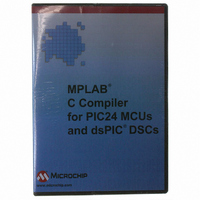SW006012 Microchip Technology, SW006012 Datasheet - Page 111

SW006012
Manufacturer Part Number
SW006012
Description
C COMPILER FOR DSPIC30F FAMILY
Manufacturer
Microchip Technology
Type
MPLAB® C30 Compilerr
Series
PIC24 & DsPICr
Specifications of SW006012
Supported Families
PIC24, DsPIC30F And DsPIC33F
Core Architecture
PIC, DsPIC
Kit Contents
Software And Docs
Mcu Supported Families
PIC24 MCUs And DsPIC DSCs
Tool Type
Compiler
Processor Series
PIC24, dsPIC
Lead Free Status / RoHS Status
Not applicable / Not applicable
For Use With/related Products
dsPIC30F
Lead Free Status / Rohs Status
Lead free / RoHS Compliant
- Current page: 111 of 248
- Download datasheet (3Mb)
7.8
© 2007 Microchip Technology Inc.
ENABLING/DISABLING INTERRUPTS
Each interrupt source can be individually enabled or disabled. One interrupt enable bit
for each IRQ is allocated in the Interrupt Enable Control registers (IECn). Setting an
interrupt enable bit to one (1) enables the corresponding interrupt; clearing the interrupt
enable bit to zero (0) disables the corresponding interrupt. When the device comes out
of reset, all interrupt enable bits are cleared to zero. In addition, the processor has a
disable interrupt instruction (DISI) that can disable all interrupts for a specified number
of instruction cycles.
The DISI instruction can be used in a C program through inline assembly. For example,
the inline assembly statement:
__
will emit the specified DISI instruction at the point it appears in the source program. A
disadvantage of using DISI in this way is that the C programmer cannot always be sure
how the C compiler will translate C source to machine instructions, so it may be difficult
to determine the cycle count for the DISI instruction. It is possible to get around this
difficulty by bracketing the code that is to be protected from interrupts by DISI
instructions, the first of which sets the cycle count to the maximum value, and the
second of which sets the cycle count to zero. For example,
__
/* ... protected C code ... */
__
An alternative approach is to write directly to the DISICNT register to enable interrupts.
The DISICNT register may be modified only after a DISI instruction has been issued
and if the contents of the DISICNT register are not zero.
__
/* ... protected C code ... */
DISICNT = 0x0000; /* enable interrupts */
For some applications, it may be necessary to disable level 7 interrupts as well. These
can only be disabled through the modification of the COROCON IPL field. The provided
support files contain some useful preprocessor macro functions to help you safely
modify the IPL value. These macros are:
SET_CPU_IPL(ipl)
SET_AND_SAVE_CPU_IPL(save_to, ipl)
RESTORE_CPU_IPL(saved_to)
For example, you may wish to protect a section of code from interrupt. The following
code will adjust the current IPL setting and restore the IPL to its previous value.
void foo(void) {
}
int current_cpu_ipl;
SET_AND_SAVE_CPU_IPL(current_cpu_ipl, 7);
RESTORE_CPU_IPL(current_cpu_ipl);
Note:
asm
asm
asm
asm
/* protected code here */
__
__
__
__
volatile ("disi #16");
volatile("disi #0x3FFF"); /* disable interrupts */
volatile("disi #0x0000"); /* enable interrupts */
volatile("disi #0x3FFF"); /* disable interrupts */
Traps, such as the address error trap, cannot be disabled. Only IRQs can
be disabled.
/* disable interrupts */
Interrupts
DS51284F-page 105
Related parts for SW006012
Image
Part Number
Description
Manufacturer
Datasheet
Request
R

Part Number:
Description:
Manufacturer:
Microchip Technology Inc.
Datasheet:

Part Number:
Description:
Manufacturer:
Microchip Technology Inc.
Datasheet:

Part Number:
Description:
Manufacturer:
Microchip Technology Inc.
Datasheet:

Part Number:
Description:
Manufacturer:
Microchip Technology Inc.
Datasheet:

Part Number:
Description:
Manufacturer:
Microchip Technology Inc.
Datasheet:

Part Number:
Description:
Manufacturer:
Microchip Technology Inc.
Datasheet:

Part Number:
Description:
Manufacturer:
Microchip Technology Inc.
Datasheet:

Part Number:
Description:
Manufacturer:
Microchip Technology Inc.
Datasheet:










